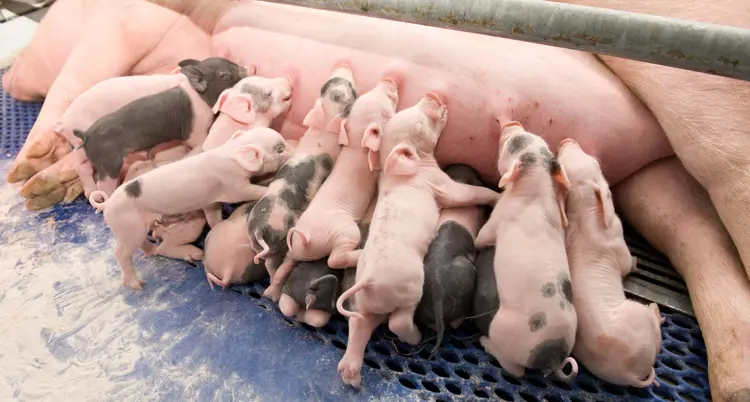Feeding lactating sows – a practical approach
Today, the total number of piglets born per sow has significantly increased, and sows are capable of producing more milk per kilogram of live weight than cows. Sow farmers, together with their suppliers and advisors, have made remarkable progress in improving performance and efficiency. However, despite these advancements, there is still a lot of variation between individual sows on a farm. For many farmers, the main goal is to maintain these results as efficiently as possible whilst minimising problems. The key to success lies in a practical approach to feed strategy based on the individual sow.

The need for an individual approach to feeding
Why is it so important that the feed strategy continues to be based on individual sows, even when there is a large number of sows on a farm? Graph 1 shows the milk production of individual sows in kilograms per day. These days, milk production per sow is a lot higher, about 1 kg per piglet per sow per day. Even more important is the significant variation among sows. This variation proves that a different feeding schedule or diet should be applied to each different sow. Yet, most farmers still have only one lactation feed, and their feeding schedule during lactation goes up similarly and reaches the same ceiling for each sow. So let’s have a look at the requirements of different sows in lactation.
Modelling feed requirements
We can simulate the feed requirement of a sow during lactation in a technical model. On the left is the requirement of a first parity sow, and on the right is a fifth parity sow. The gray line shows a commonly used average feed schedule. Of course, the outcome of these calculations not only depends on production but also on the estimated amount of weight loss.
From these results, we can draw two important conclusions:
- The sow is underfed, particularly at the beginning of lactation. This increases body condition loss.
- In the second part of lactation, less prolific sows are fed above requirements. She, therefore, returns to a positive energy balance.
How do you manage these two important conclusions?
1. Prevent underfeeding in the first two weeks of lactation:
The most logical step to prevent underfeeding would be to push the feed intake as much as possible but this won’t work. To be able to push the feed from day 1 after farrowing, you have to rely on the capacity of the sow to metabolise her own body reserves before farrowing. The sow will already go into a negative energy balance from at least 10 days before farrowing. This is not a problem because it’s natural, so don’t push this and let the sow handle it. Of course, you have to support this transition. A separate transition feed would be very helpful:
- Avoid constipation with a fibre-rich diet
- Slow-release energy by short-chain fatty acids produced by fermentation of fibers
- Support physiological processes with Additional products like omega 3 fatty acids, specific amino acids, specific B vitamins, (endo) toxin binder
Increase feed levels directly after farrowing
After farrowing, when the sow is fit (because you didn’t push her) you can easily increase the feed intake directly after farrowing. We have achieved very good results with feed levels up to 4.5 kg on day 1 after farrowing in multiparous sows. Please note that the sow should be standing and have a good appetite, to use these feeding levels. Koudijs has developed a complete approach. Contact us if you are interested in discussing this.
2. Prevent a positive energy balance in the second half of lactation:
In the second half of lactation, you are already making choices for the next parity. Sows need to be in an “optimal-negative-energy balance.” The negative energy balance should, of course, not be too low as problems may arise from this. As you can see in the graphs, there are also sows or situations on the farm where requirements for production might be lower than the supply. It’s important to anticipate these situations and make the right choices around 10 days after farrowing. By doing so, you will definitely avoid a lot of problems with fertility in the next litter.
Adopt the right feed regime
An optimum feed regime for a lactating sow is based on first PULL and only afterward PUSH in the first half of lactation. In the second half of lactation, you should have a practical structure to feed the sow based on the estimated milk production. Managing this well will increase your results by avoiding mistakes, and this will give you a lot more job satisfaction.
